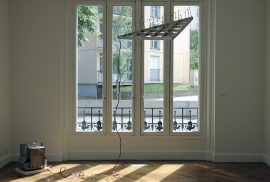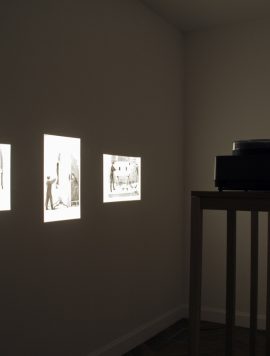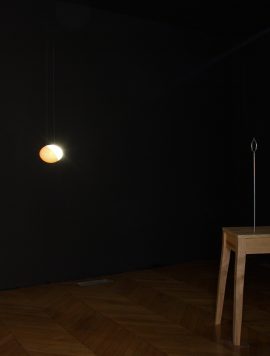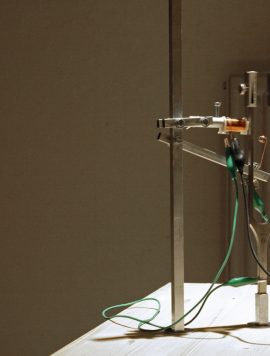Tales of disbelief
In 1901 a book titled Thought Forms was published in London. Its authors, Annie Besant and Charles Webster Leadbeater, were practitioners of Theosophy, an esoteric doctrine that had made its appearance in the late 19th century and attempted to reconcile psychic phenomena with the latest scientific theories. The book defended the possibility of visualize immaterial forms generated by thoughts and emotions. The illustrations – paintings based on descriptions of such forms – showed vividly coloured abstract figures floating against an opaque backdrop or over buildings. Curiously some of these images seemed to anticipate by some years, and even decades, certain trends and styles in abstract art.
Ideas, convictions and fanciful stories like these are part of the concept underlying the “Tales of Disbelief” exhibition. They belong to a current which for many years – despite the problems involved in setting chronological limits, we can speak of a period between the 19th and mid-20th centuries – concentrated on the links between science, aesthetics and practices now described as irrational. Out of this period came, among many other things, spirit photography, important technological innovations which at the time still passed for wonders, attempts at rational explanation of psychic phenomena, and the search for a source of permanent “free” energy.
The seven participating artists, many of them showing in France for the first time, address these issues from a complex and even ambiguous point of view. On the one hand they are aware of examining a virtually closed chapter in the history of ideas; however the subject holds an aesthetic fascination for them, even as they stress the cultural distance separating us from certain beliefs and theories. And on the other hand they point up the capacity of these beliefs and theories, even today, to call into question the boundaries of what we consider real, rational
and plausible.
This stance can be situated in terms of the famous aesthetic theory of Samuel Taylor Coleridge, the English Romantic poet who formulated the relationship between the reader and a work of fiction as founded on a “suspension of disbelief”, a provisional abandoning of the critical faculty that enabled emotional involvement in the narrative. The exhibition’s title invokes the opposite possibility, suggesting a relationship with narrative – or more likely a set of “narratives” arising out of a clearly defined past – based as much on disbelief as on belief.
Drawing on this duality, English artist Kit Craig has made a series of drawings inspired by Besant and Leadbeater’s Thought Forms. In the course of the two-way translator/traitor movement he sets up – from illustrations to sculptures and from sculptures to the drawings on show here – the significance of the original images and of the theoretical foundations of Theosophy is undermined. The impossibility of a return to this significance then becomes a source of fascination, and these meaningless objects turn into Surrealistic assemblages, items from a cabinet of curiosities.
This interest in improbably heterodox, metascientific thought systems makes Craig’s work similar to that of Athanasios Argianas, Nick Laessing, and João Maria Gusmão + Pedro Paiva, all of whom test the capacity of these systems to challenge certain current concepts. These artists also focus on the instruments and devices that have sprung from such systems, emphasising the paradox of technologies which, reduced to obsolescence by their distance from today’s science, once again become utterly foreign to us. João Maria Gusmão + Pedro Paiva offer an “entropic” version of a model of the human eye dating from the 17th century. Nick Laessing presents a faithful replica of a machine which, according to its inventor, can generate small quantities of energy out of nothing. The two sculptures Athanasios Argianas has made specifically for the exhibition seem to lie somewhere between a theory of forms (gestalt) and the machines French writer Raymond Roussel dreamed up in his novels.
Christian Frosi and Goshka Macuga’s interest goes to the emotional and psychological content of these epistemological systems. Both speculate about the historical and cultural circumstances that shape our capacity for wonderment. Goshka Macuga uses illustrations from a late-19th-century book exposing magicians’ tricks: her goal seems to be an archaeology of disenchantment and a search for the turning point in our relationship with magic. Christian Frosi looks into the viewer’s expectations in respect of science and technology, offering a scientific, real-time experiment in levitation without really pulling it off. He also draws on the past by trying to recreate the astonishment, not to say stupefaction of the first witnesses of television.
In addition to their concern with the themes taken up by the exhibition, the artists have certain aesthetic choices in common. Thus they set aside the digital in favour of such analogue media as traditional photography and cinema, whose history goes back to the 19th century and which put forward ambiguous versions of the “truth”. They also have recourse to figurative painting, not as a means of depicting reality, but as a tool for illusion and persuasion. Ulla von Brandenburg commits herself thoroughly to this approach with her watercolours and the 16mm film Geist, which take their inspiration from the spirit photography in vogue in the 19th and 20th centuries.
The artists of “Tales of Disbelief” are neither turning nostalgically towards the past nor seeking to provide forms of escapism, seduction or the exotic. Rather they show the extent to which cultural history is marked by grey areas and unanswered questions; and they do so in such a way that they succeed, through their works, in bringing a new eye to bear on the present.
Simone Menegoi
Translated by John Tittensor
around the exhibition
-
14/06/2008
From 6:00 to 8:00 pm
Talk on spiritualist photography by Clément Chéroux, curator, and discussion with Simone Menegoi. -
19/06/2008
From 7:15 to 8:45 pm
Workshops: “A Time for Art” – Cycle 4 : “Tales of Disbelief”- Interpretation of the works in three sessions, including a tour of the show
“Traces du sacré” at the Centre Pompidou in Paris. -
29/06/2008
5:00 pm
Films projection and discussion with João Maria Gusmão + Pedro Paiva, at La Maison rouge, Fondation Antoine de Galbert, Paris.





